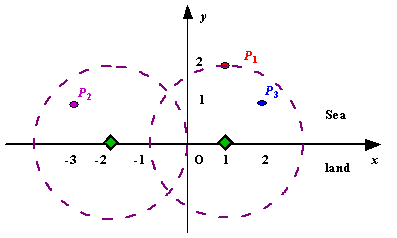poj1328Radar Installation(貪心+區間選擇)
阿新 • • 發佈:2019-01-29
Radar Installation
We use Cartesian coordinate system, defining the coasting is the x-axis. The sea side is above x-axis, and the land side below. Given the position of each island in the sea, and given the distance of the coverage of the radar installation, your task is to write a program to find the minimal number of radar installations to cover all the islands. Note that the position of an island is represented by its x-y coordinates.

Figure A Sample Input of Radar Installations
The input is terminated by a line containing pair of zeros
| Time Limit: 1000MS | Memory Limit: 10000K |
| Total Submissions: 80210 | Accepted: 17922 |
Description
Assume the coasting is an infinite straight line. Land is in one side of coasting, sea in the other. Each small island is a point locating in the sea side. And any radar installation, locating on the coasting, can only cover d distance, so an island in the sea can be covered by a radius installation, if the distance between them is at most d.We use Cartesian coordinate system, defining the coasting is the x-axis. The sea side is above x-axis, and the land side below. Given the position of each island in the sea, and given the distance of the coverage of the radar installation, your task is to write a program to find the minimal number of radar installations to cover all the islands. Note that the position of an island is represented by its x-y coordinates.

Figure A Sample Input of Radar Installations
Input
The input consists of several test cases. The first line of each case contains two integers n (1<=n<=1000) and d, where n is the number of islands in the sea and d is the distance of coverage of the radar installation. This is followed by n lines each containing two integers representing the coordinate of the position of each island. Then a blank line follows to separate the cases.The input is terminated by a line containing pair of zeros
Output
Sample Input
3 2 1 2 -3 1 2 1 1 2 0 2 0 0
Sample Output
Case 1: 2 Case 2: 1 解題思路:該題題意是為了求出能夠覆蓋所有島嶼的最小雷達數目,每個小島對應x軸上的一個區間,在這個區間內的任何一個點放置雷達,則可以覆蓋該小島,區間範圍的計 算用[x-sqrt(d*d-y*y),x+sqrt(d*d-y*y)];這樣,問題即轉化為已知一定數量的區間,求最小數量的點,使得每個區間內鬥至少存在一個點。每次迭代對於第一個區間,選 擇最右邊一個點, 因為它可以讓較多區間得到滿足, 如果不選擇第一個區間最右一個點(選擇前面的點), 那麼把它換成最右的點之後,以前得到滿足的區間, 現在仍然 得到滿足, 所以第一個區間的最右一個點為貪婪選擇, 選擇該點之後, 將得到滿足的區間刪掉,進行下一步迭代, 直到結束。
#include
#include
#include
#include
using namespace std;
struct node{
double left;
double right;
}point[1005];
int cmp(node a,node b){
return a.leftd){
flag=1;
}
}
if(flag){
printf("Case %d: -1\n",cas++);
}
else{
sort(point,point+n,cmp);
temp=point[0].right;
for(int i=1;itemp){
sum++;
temp=point[i].right;
}
}
printf("Case %d: %d\n",cas++,sum);
}
}
}